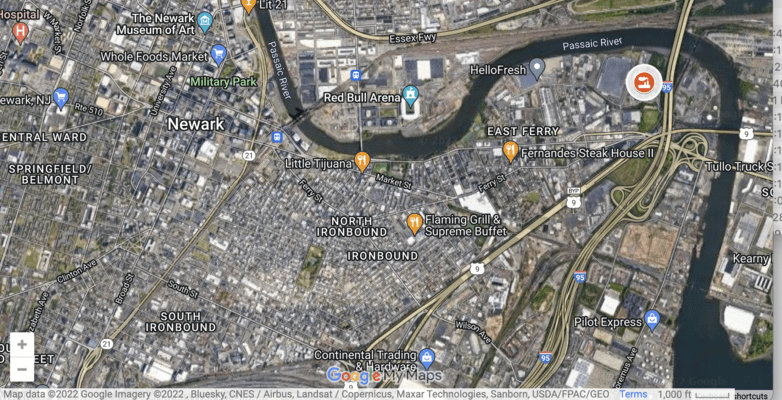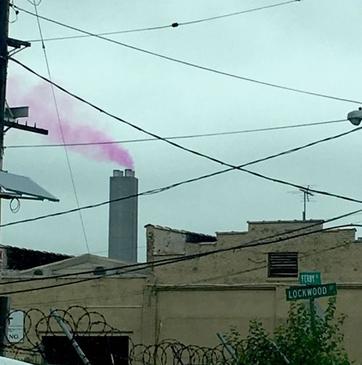
Don’t Trash the Ironbound
How one community is fighting incinerator pollution
Map data© Google Imagery ©2022, Bluesky, CNES / Airbus, Landsat / Copernicus, Maxar Technologies, Sanborn, USDA/FPAC/GEO
In the heart of the vibrant Ironbound community of Newark, NJ, you don’t have to look far to see what injustice looks like. Some days, you just have to look up to see the thick plume of bright pink and purple smoke billowing out of the state’s largest waste incinerator.
Covanta – the company that operates the incinerator along with 36 similar facilities across the US – admits the pink smoke is from burning pesticides.
According to the National Academy of Sciences, inhaling iodine, one of the major ingredients in the toxic cocktail streaming out of the smokestacks, causes severe breathing difficulty. Higher levels of exposure can cause bronchitis, rapid heartbeat, and tremors, among other outcomes. The Ironbound incinerator is part of a long list of nearby potential polluters in a city where children suffer from asthma rates three times higher than the state average.
While New Jersey's air quality is improving for the most part, a recent report by the American Lung Association finds, in one county, Essex County, air quality is actually worsening. In Newark – the county seat of Essex County – the daily and yearly measures for particulate matter pollution in the air are increasing.
The difference matters. The Ironbound is what the state calls an “overburdened community,” where at least 35% of households qualify as low income and at least 40% of community members identify as minority, among other factors. And it’s not alone as a community where lower-wealth families and people of color breathe in toxins.
Sixteen of the 20 largest incinerators in the country are located in communities with populations of color above the national average and 14 of them in communities where people of color make up the majority of residents. All of which makes the discrimination and injustice at work as clear as pink smoke in a bright blue sky.
And in the Ironbound, residents are refusing to quietly go along with it, joining forces with the Los Angeles-based East Yard Communities for Environmental Justice and other groups to sue the Environmental Protection Agency (EPA) to do its job and, well protect them from pollution (more on that below).
Terrible for our communities. Terrible for the planet.
Sometimes the worst injustices come with a green smile and a great-for-the-environment pitch.
Covanta, the Ironbound plant’s operator, burns some 20 million tons of trash each year in what they call “waste-to-energy” or “energy from waste” facilities, turning the heat from incinerated garbage into steam driving turbines that generate electricity. In Newark, the company burns 1 million tons of trash annually for this purpose under the pretext of reducing emissions and creating sustainable alternatives to landfills.
There’s just one problem: None of this is true.
Using industry and government data, an analysis by Energy Justice Network found that trash incinerators are the most expensive and polluting way to manage waste or to make electricity. That they’re dirtier than burning coal, and are worse than landfills. They also found that for every 100 tons of waste burned, 30 tons of toxic ash are produced and dumped in landfills, making the landfills smaller, but more toxic. The other 70 tons leave the smokestack as steam, global warming pollution, and a myriad of other pollutants that may contribute to asthma, cancers, heart attacks, birth defects, learning disabilities, and many other health problems. Trash incinerators can emit up to 2.5 times as much climate changing carbon pollution per unit of energy than a coal power plant.
That on top of releasing toxic dioxins and heavy metals that are quite harmful to public health. Hardly sustainable and certainly dangerous.
Time for EPA to Step Up
Taking control of their air and health, one local organization, Ironbound Community Corporation joined by Earthjustice, Sierra Club, and East Yard Communities for Environmental Justice in Los Angeles – is suing EPA to update its incinerator regulations.
The Ironbound is not just fighting for Newark. Roughly 1.6 million Americans live close to incinerators, with the majority in lower-income household and communities of color. With a few rare exceptions, the fleet of 71 commercial trash incinerators in the US are nearing their last decade of life. The average trash incinerator is now 33.5 years old while the average age of the 45 facilities that closed since 2000 was just 23 when they retired. As incinerators age, they break down more often, sometimes causing increased releases of toxic pollutants into the air we breathe.
Advocates around the country are fighting for the closure of incinerators in their communities. This lawsuit is just one new front in the battle.
Because of its responsibility to Congress and the nation, EPA does not have a choice but to update incinerator regulations. But when it does, we must be ready to fight to replace careless regulations for rules that ensure the health of all Americans.
To learn more about incinerators and the fight for clean air and environmental justice, visit Energy Justice Network.





